On Tuesday evening, the Tbilisi State Conservatoire hosted a performance by Canadian pianist Marc-André Hamelin as part of the 2025 edition of Tbilisi Piano Fest. The appearance of a figure long respected for his analytical clarity and technical control lent a measured gravity to the festival’s opening, which otherwise leans toward showcasing virtuosity and international appeal.
The program spanned Classical precision and Romantic interiority, moving from Haydn and Beethoven to Medtner and Rachmaninov. Hamelin’s choices—neither crowd-pleasing nor obscure—reflected a characteristic interest in works that test the pianist’s ability to navigate between formal discipline and expressive ambiguity.
Hamelin opened with Haydn’s Sonata in D major, Hob. XVI:37, a compact but structurally intelligent work often underestimated in recital settings. His interpretation avoided exaggerated contrast or decorative phrasing, instead allowing the rhetorical shape of the piece to speak through restrained articulation and clarity of texture. The approach served as a statement of method—eschewing effect in favor of attention to structure.
Beethoven’s Sonata in C major, Op. 2 No. 3 followed. Hamelin’s reading was marked by precision and a refusal to dramatize beyond the score’s inherent momentum. The first movement’s rhythmic insistence emerged as a kind of architectural challenge—form pushing against itself. In the slow movement, Hamelin resisted sentimentality, maintaining an internal tension that kept the lyricism from collapsing into expressive vagueness. This was a Beethoven shaped more by contour and cadence than by psychological drama.
In the second half, the program shifted toward the early 20th century with works by Nikolai Medtner—the Improvisation in B-flat minor, Op. 31 No. 1, and Danza Festiva, Op. 38 No. 3. Hamelin is one of the few pianists today who approaches Medtner not as a curiosity, but as a composer with a self-sustaining formal logic.
In the Improvisation, he traced the line of variation with patient control, allowing motivic development to unfold without rhetorical inflation. His approach to rhythm was flexible but unsentimental; rubato was used not for emotional effect but for structural clarification. The Danza Festiva, lighter in tone, was treated with similar economy, revealing the underlying counterpoint beneath its surface gestures.
The recital concluded with Rachmaninov’s Étude-Tableau in E-flat minor, Op. 39 No. 5, and the Second Sonata in B-flat minor, performed in the composer’s revised 1931 version. Hamelin approached these pieces with notable restraint. Rather than emphasizing the work’s inherent drama, he foregrounded the sonata’s compressed structure and motivic interrelations.
This was not Rachmaninov as an exercise in late-Romantic excess, but as a study in thematic condensation. The final movement’s virtuosic demands were navigated with clarity and discipline, but without ostentation. It was an interpretation shaped by internal coherence rather than expressive projection.

Interpretation as Inquiry
Throughout the evening, Hamelin offered not a display of pianistic personality but a set of interpretations grounded in formal attention and musical literacy. His playing remains a reminder that virtuosity, when subordinate to structure, can serve as a vehicle for thought rather than an end in itself.
In a festival context that will include performers with more demonstrative styles and extroverted programming, Hamelin’s recital stood apart—less an event, more a reading. For audiences willing to listen closely, it was a lucid proposition: that the pianist’s role is not to entertain or emote, but to think in sound.
Tbilisi Piano Fest 2025 continues through June 28, with upcoming performances by Konstantin Lifschitz, Francesco Libetta, Andrius Žlabys, and Martín García García, among others.
Founded and curated by Dudana Mazmanishvili, the Tbilisi Piano Fest has, over the past years, developed into one of the region’s more thoughtfully assembled platforms for pianistic exchange. Eschewing superficial glamour, the festival focuses on presenting a broad spectrum of interpretative aesthetics—from historically informed performance to modernist virtuosity—within a setting that encourages close listening and critical engagement. Held across several of Tbilisi’s academic and public venues, the festival aims not merely to showcase technical brilliance, but to position the piano recital as a site of cultural discourse. With its combination of international guests and Georgian artists, it also serves as a bridge between the city’s conservatoire tradition and its more contemporary musical ambitions. Under Mazmanishvili’s direction, the festival operates less as a spectacle and more as a curatorial proposition: what does it mean to listen with seriousness—and what does the piano still have to say in a culture saturated with images and noise?
By Ivan Nechaev














